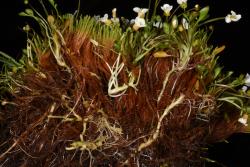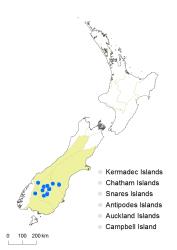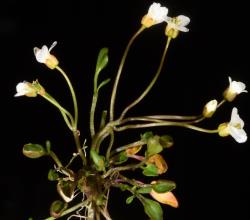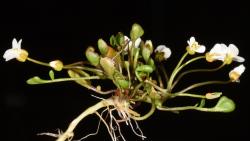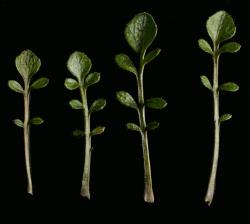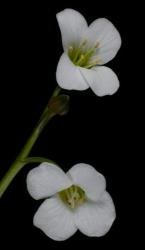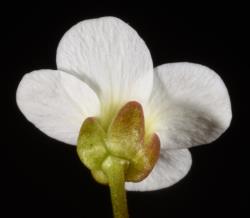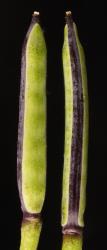Perennial herb, single rosette or with lateral, prostrate or decumbent, often with rhizomatous stems. Leaves up to 95 mm long, pinnatisect; lamina 5.0–35.0 × 3.5–34.0 mm, green, coriaceous, glabrous on abaxial surface, glabrous or sparsely to moderately hairy on adaxial surface and petiole; hairs up to 0.4 mm long, spreading to patent; petiole up to 75 mm long. Terminal pinna 2.5–13.0 × 2.0–14.8 mm, simple, orbicular-rhomboid, rhomboid, broadly elliptic-rhomboid to broadly elliptic; margin entire to shallowly sinuate, with 2–4 indistinct hydathodes; apex obtuse with a ± distinct hydathode; base attenuate to obtuse, occasionally truncate. Lateral pinnae 2–6, 1.0–13.0 × 0.6–8.3 mm, orbicular to broadly elliptic-orbicular; apex obtuse; base attenuate; petiolule sessile or up to 5.0 mm long. Cauline leaves absent. Inflorescence corymbose, each corymb 2–3-flowered or flowers solitary; peduncle up to 45 mm long, 0.3–0.4 mm diam. at base, spreading to ascending, glabrous. Pedicels 6.0–145.0 mm long, 0.3–0.4 mm diam., glabrous. Sepals 2.2–3.4 × 1.0–1.8 mm, elliptic-oblong to broadly elliptic-obovate, saccate, green or reddish brown, glabrous or occasionally sparsely hairy, margin white and membranous, apex obtuse, base truncate. Petals 6.5–9.7 × 3.0–5.6 mm, white, limb obovate; apex obtuse; base attenuate to cuneate, tapering to a 2.0–2.5 mm long claw. Stamens 6; median filaments 4, 3.6–5.2 mm long; lateral filaments 2, 2.0–3.7 mm long; anthers 0.9–1.0(–2.2) mm long, cream to pale yellow, when dehiscent held at a similar height to or slightly below the stigma. Ovary 5.0–6.4 mm long, 0.5–0.9 mm diam., ± terete, green, glabrous; ovules 28–36; style (1.2–)2.5–3.0 mm long, ± terete; stigma 0.35–0.45 mm diam. Siliques 11.0–15.0 × 1.5–1.7 mm, glabrous, style 1.6–2.0 mm long; valves green at maturity and when dehiscent; replum 0.2–0.3 mm wide. Seeds 1.3–1.7 mm long, 0.8–1.1 mm wide, 0.2–0.4 mm thick, oblong to broadly oblong, henna to henna-green; wing absent.
Cardamine reptans is distinguished from C. megalantha by its membranous leaves with indistinct marginal hydathodes and smaller terminal leaflet, and in having several lateral leaflets, leaflets often with indistinct petiolules and lacking axillary hydathodes, and short inflorescences.
South Island: Westland, Canterbury, Otago, Southland.
Cardamine reptans is known from the schist mountains of Otago and Canterbury, including St Mary’s Range, St Bathans Range, Dunstan Mountains, Old Man Range, Pisa Range, Remarkables and Crown Range, and Southland (Garvie Mountains).
Cardamine reptans occurs in a variety of subalpine and alpine habitats such as seepages, damp stream margins, moist hollows, bog margins, and wet hollows in alpine cushion vegetation.
Cardamine reptans is assessed as having a conservation status of At Risk—Naturally Uncommon, with the qualifier Data Poor (de Lange et al. 2018). The qualifier Data Poor is applied because additional information on the number and size of the populations is required.
Flowering December–February; Fruiting January–February.



